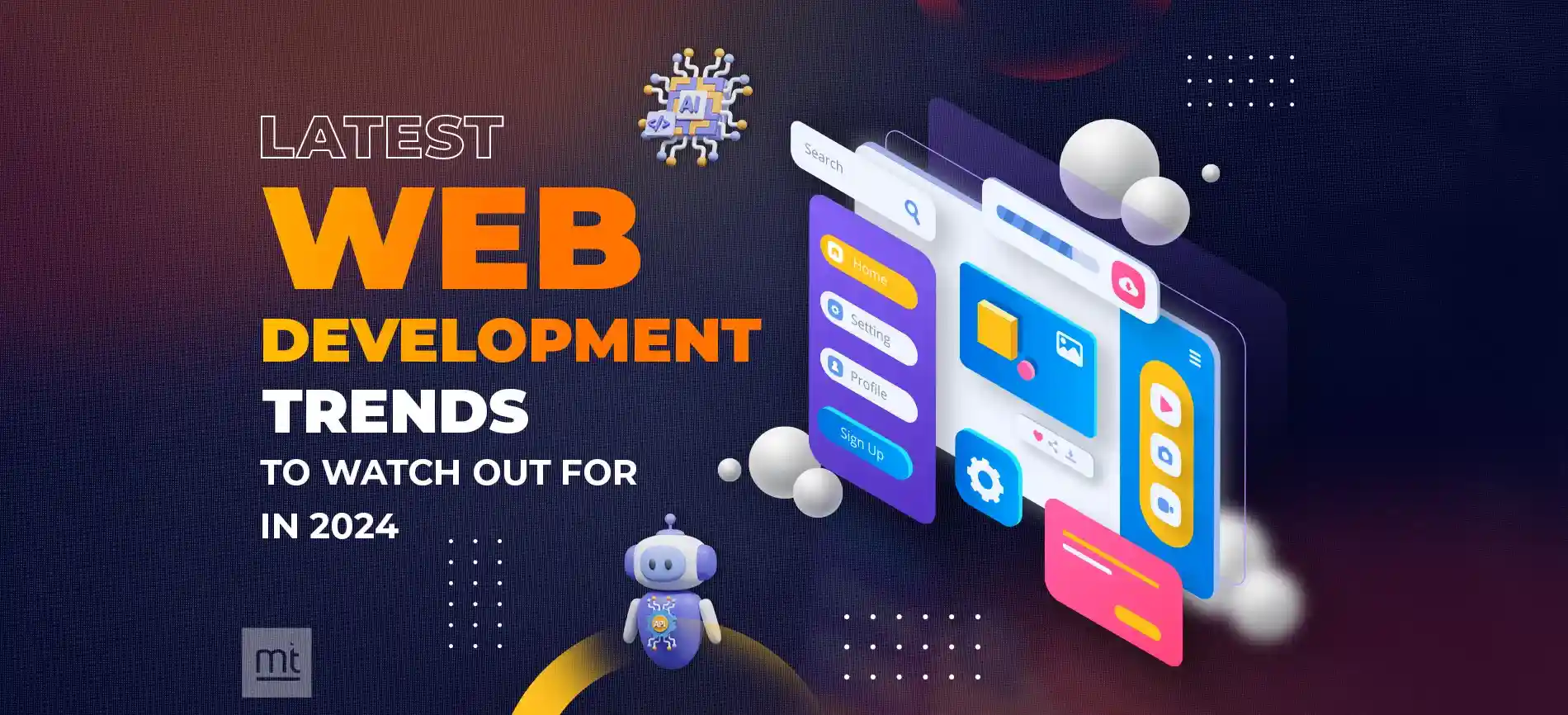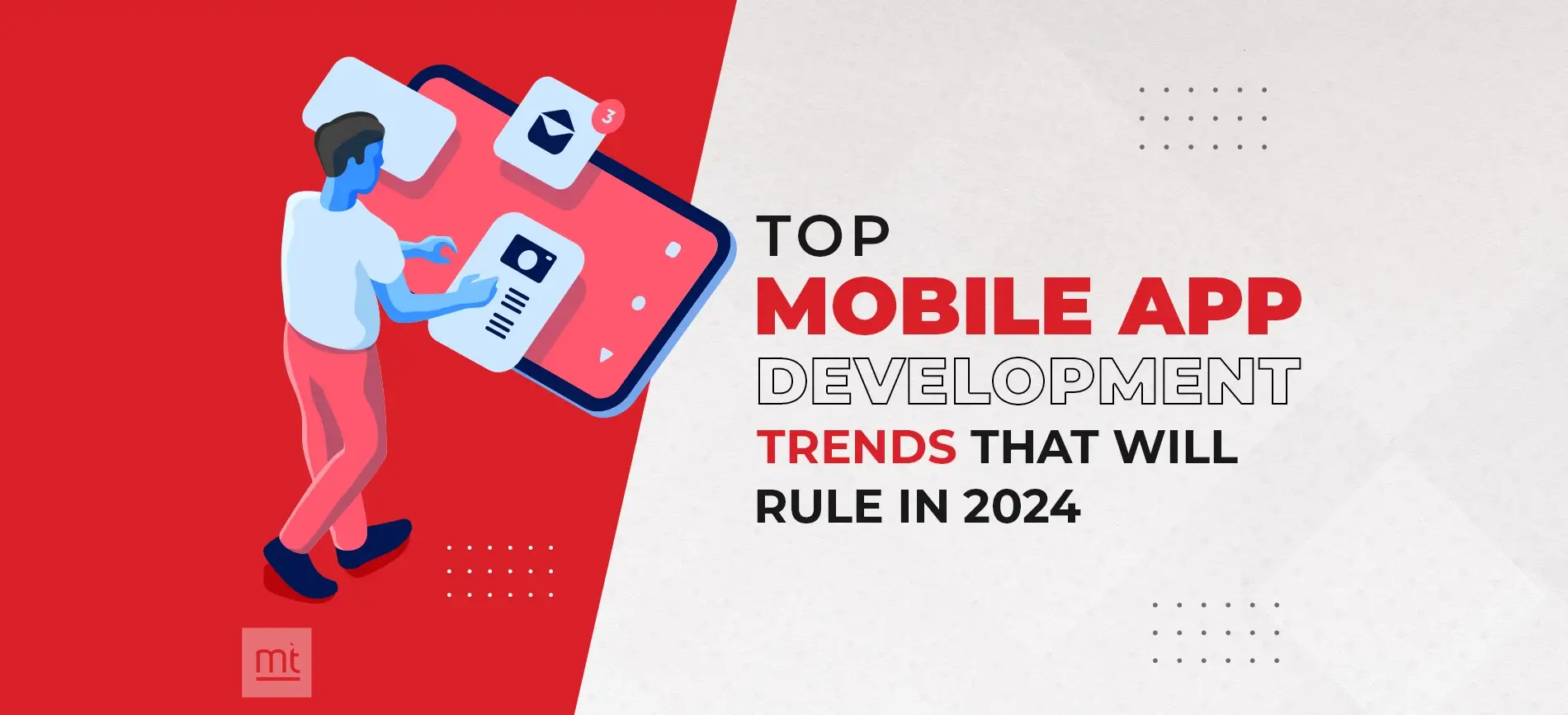Key Takeaways:
Did you know Cloud computing was already booming in 2020? Today, in the digital era, cloud computing is an essential part of the IT industry. According to O’Reilly’s latest Cloud Adoption report, more than 90% organizations adopt cloud computing services and their architecture supporting big data analytics. AI & ML models, advanced Business Intelligence and IoT. Based on the stats, most IT organizations want to adopt current trends of cloud computing because they want to achieve business scale growth, enhance data security, so there are some questions raised in their minds:
- Is Cloud Computing useful in Information Technology?
- What is Cloud Computing?
- What are the recent trends in Cloud Computing in 2025 and beyond?
- What are the main benefits of Cloud Computing in 2025
Overview of Cloud Computing Market Statistic
Today, Cloud Computing is rising in the IT market. Do you want to know why Cloud computing will be in high demand currently and in the upcoming years? Let’s look at here stats from the resource and report:
As per the Precedence Research, the cloud computing market will surpass $1 trillion globally by 2028.
Today, 80% of organizations use multiple public or private clouds.
Furthermore, based on the report of RightScale resource, 94% of enterprise organizations are adopting cloud computing services. Nowadays, more enterprises are finding a hybrid cloud or multi-cloud instead of using a public or private cloud strategy.
Based on Vmare research, Modernizing and integrating apps with public cloud services is a top priority in the next three years.
Here,our ManekTech experts provide a detailed explanation of everything you want to know about cloud computing trends and their benefits.
Is Cloud Computing useful in Information Technology?
Yes, cloud computing is useful in Information Technology. Every IT industry raises this question today: Why are cloud computing services useful in IT organizations? Among the IT industry areas that are developing drastically, cloud computing is one of them.
- With the help of cloud services, businesses can expect to increase productivity to a new level while handling consumer data.
- Keeping up with cutting-edge cloud technologies has become essential. If you are not using it, then you are missing out on a big deal.
To find out what it is and the cloud computing trends that will dominate in 2025 and beyond, take a look by reading to the end.
What is Cloud Computing?
Did you know that the cloud computing market is expected to be worth $947.3 billion? It is known that around 60% of business data is stored in the cloud which makes it easy to predict the existence of trends in cloud computing.
Whoever is still not sure of what “cloud computing“ is, must know that it is a framework that offers online access to computer resources like servers, storage, databases, etc. It acts as an alternative to local hardware and infrastructure. This implies that individuals with any device that has an internet connection can access these materials at any time and from anywhere in the world.
What are the Different Types of Cloud Computing Services?
There are 5 main types of cloud computing services like PaaS, SaaS, IaaS, FaaS and XaaS. Cloud computing allows full use of the technology. But first understand the types of cloud computing development services available as given below in detail:.
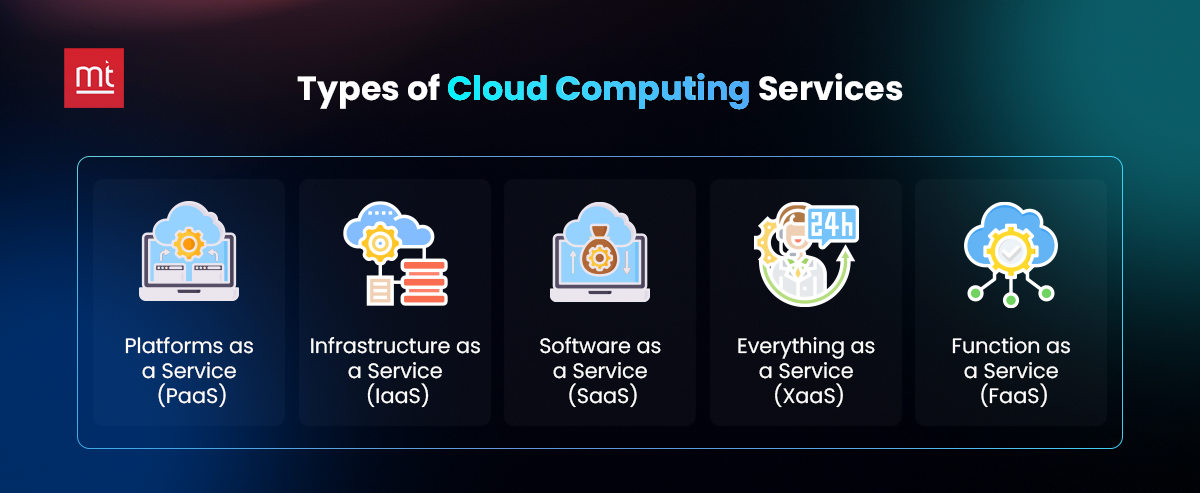
1. Platforms as a Service (PaaS)
PaaS or Platforms as a Service offers runtime environments, middleware and development tools for creating, testing and deploying applications. Abstracting cloud infrastructure management expedites the development process and promotes quick innovation.
2. Infrastructure as a Service (IaaS)
A type of cloud computing known as Infrastructure as a Service ( IaaS) uses the internet to deliver virtualized computer resources. An IaaS supplier delivers servers, storage and networking as a part of a pay-as-you-go IT infrastructure. It makes it possible to handle different workloads through scalability and flexibility.
3. Software as a Service (SaaS)
Through web browsers or APIs, SaaS or Software as a Service provides fully working SaaS app development services through the internet. This improves user experience and productivity.
4. Everything as a Service (XaaS)
Delivering anything as a service is collectively referred to as XaaS. It includes all of the many goods, instruments and technology that suppliers provide to customers as a service through a network, usually the Internet.
5. Function as a Service (FaaS)
FaaS or Function-as-a-Service is a serverless approach for running modular programs at the boundary. With FaaS, developers can quickly build and modify code.
How Does Cloud Computing Benefit Enterprises?
Before finding out the future technology trends in cloud computing, Cloud computing offers several benefits to organizations, such as cost savings, improved security, quality control, increased collaboration, rapid application deployment, enhanced scalability, and more. Let’s take a look at the best 5 advantages of cloud computing that it offers to enterprises:
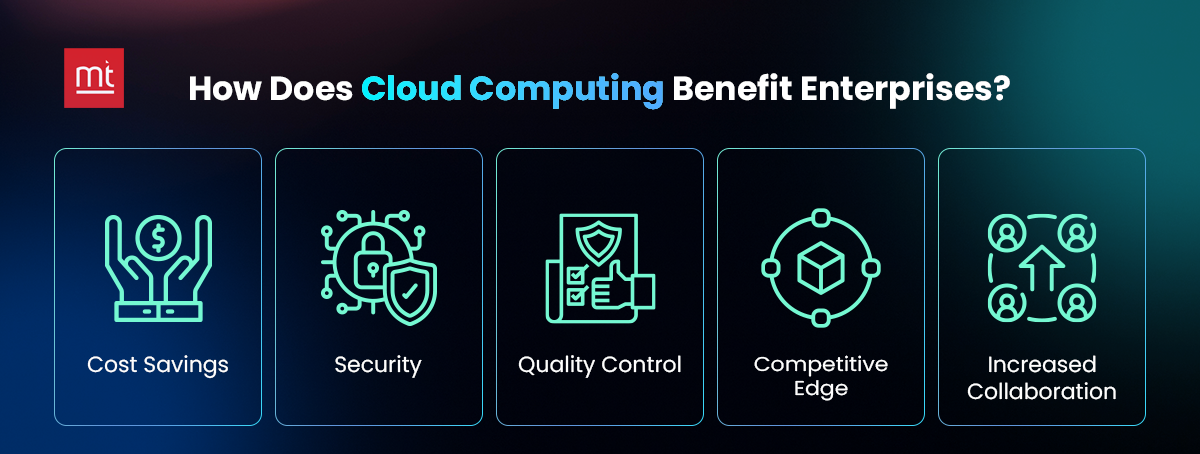
#1. Cost Savings
Cloud computing reduces capital expenditure and lowers operational costs including the need to hire dedicated developers. Besides that, it ensures scalability without significant infrastructure investments.
💡Pro Tips: Hire highly professional and skilled developer from ManekTech who reduce your operation cost and ensure your infrastructure investments.
#2. Security
It ensures robust data protection as it comes with built-in security features that enhance compliance and reduce risk.
💡Pro Tips: ManekTech have dedicated developers team to setup secure cloud to reduce operation cost with ensure to increase your infrastructure investments.
#3. Quality Control
Cloud computing implements standardized processes that monitor performance and ensure consistency in quality across the organization.
💡Pro Tips: With ManekTech's cloud computing capabilities to automate monitoring performance and standardize workflows to ensure consistent quality.
#4. Competitive Edge
You can gain a competitive advantage with faster time-to-market while staying agile and innovative. It quickly deploys new app development and responds rapidly to changing market conditions.
💡Pro Tips: We ensure to rapidly deploy new app development and quickly adopt new competitive edge to deliver to the client, as well as quickly change as per the market.
5. Increased Collaboration
It enables seamless communication, collaboration and knowledge-sharing across teams, locations and devices.
💡Pro Tips: ManekTech’s cloud solutions team can easily collaborate from any location by quickly sharing files, data, and concepts.
Read More: Top 10 Mistakes to Avoid while Developing Cloud Application
8 Cloud Computing Trends 2025 To Watch Out
Keeping up with the latest technology trends can be daunting. As a result, a few of the future trends in cloud computing for 2025 and beyond include AI-powered services, Edge Computing, Cloud Cost Optimization, Multi- and Hybrid Cloud Deployment, Serverless Computing, Cloud Security and Resilience, Open Source Cloud, and more. Let’s look at it in detail so you can get an idea for your enterprises:
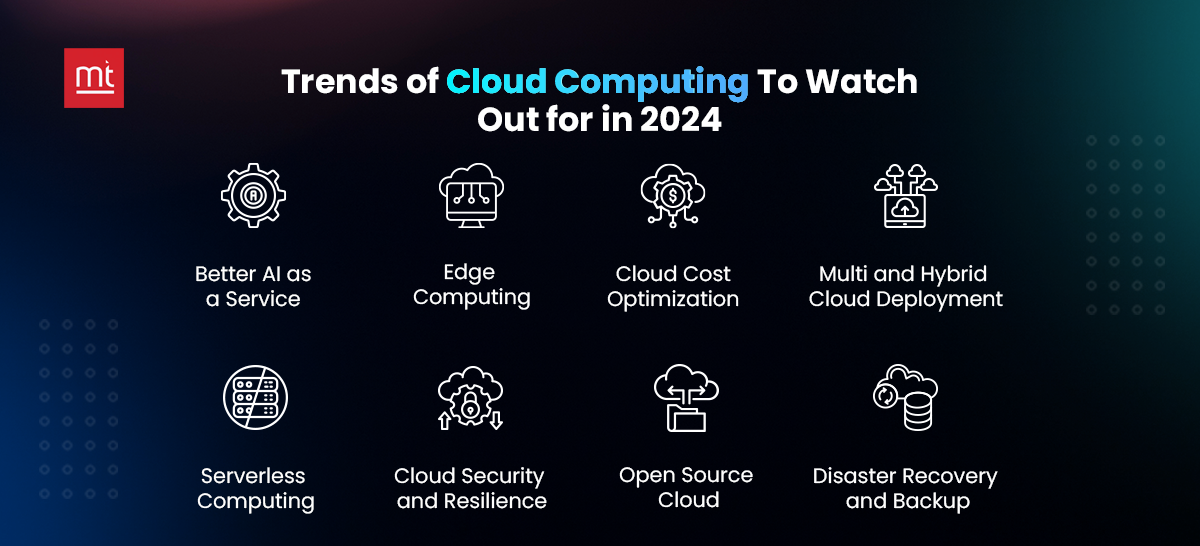
1. Better AI-Powered as a Service
Just as the name suggests, it provides Artificial Intelligence services to enterprises over the cloud saving them from having to keep their AI infrastructure and knowledge in-house. This methodology speeds up the adoption of AI technology by enabling the investigation of AI capabilities without needing to require a substantial initial expenditure.
💡 Expert Insight: Our highly skilled cloud deployment developers build cloud apps integrated with AI-powered services.
2. Edge Computing
One of the popular cloud computing industry trends is Edge Computing. As the Internet of Things ( loT ) is growing at a rapid pace, it has become essential to process data closer to its source. In this process, storing, processing and analyzing data while remaining close to the data source takes place. This method removes the need for long-distance data transfer, increases efficiency and improves data security.
💡 Expert Insight: Our team uses Edge Computing, which can improve real-time decision-making, lower latency, and enhance data security.
3. Cloud Cost Optimization
Cloud cost optimization lowers the time, energy and resources required for cloud cost tracking. This takes place by enhancing cost visibility, allocation, and budgeting. When these recent cloud computing trends take place, your engineers and staff will eventually be free to concentrate on other aspects of the business like attracting more consumers.
💡 Expert Insight: ManekTech helps you in various ways, such as removing unnecessary tools, utilizing the correct resources, and monitoring expenses in real time, so that it helps you to save money on cloud services, so that the team can focus on your company's growth.
4. Multi and Hybrid Cloud Deployment
Another major trend to set in is Multi and Hybrid Cloud Deployment. It involves eschewing the public cloud model and using the best platform for each workload and data type. When multi and hybrid cloud strategies are opted for, it fuses the advantages of on-premises infrastructure with public cloud services. It provides enterprises with benefits like flexibility, scalability, and cost-effectiveness.
💡 Expert Insight: ManekTech helps you use both your own systems and cloud services together, so your business gets more flexibility, better speed, and lower costs—without being stuck with one provider.
5. Serverless Computing
A dynamic trend to expect is Serverless Computing. Developers may write and run code without worrying about maintaining servers or backend infrastructure because of this feature. It frees developers from the hassle of server maintenance as they may just rely on writing codes.
💡 Expert Insight: Following this trend, our cloud deployment specialist assists customers in building serverless apps so they can concentrate more on their business and not worry about server maintenance.
6. Cloud Security and Resilience
To protect cloud-based systems, data and infrastructure, a wide range of policies, practices and technological advancements work together to form cloud security. Conversely, resilience describes how quickly cloud systems can bounce back from setbacks and continue to do business as usual.
💡 Expert Insight: ManekTech’s developers adopt the latest cloud security and resilience practices to help their clients keep their data safe, secure and make sure their systems keep running smoothly without any issues.
7. Open Source Cloud
Due to the increasing need of organizations for greater flexibility and control over the cloud infrastructure, open-source cloud solutions are gaining popularity. Compared to typical cloud providers, open-source cloud companies are less expensive and offer greater customization choices.
💡 Expert Insight: Our team uses these most popular tools to provide clients with greater control, flexibility, and cost-saving options that can be customized to meet their specific
8. Disaster Recovery and Backup
Businesses are starting to see how important it is when they shift their operations to the cloud. As a result, disaster recovery solutions can be expected to be seen as one of the current trends in cloud computing that will exist in the future as well. It helps businesses to quickly recover from disturbances like cyberattacks and receive backups in no time.
💡 Expert Insight: Our expert team uses this latest trend to help clients keep their data secure and recover quickly if something goes wrong like cyberattacks or system crashes.
Conclusion
Now that you know what are the trends in cloud computing, you must expect deals for substantial commitments by choosing cloud computing. As these trends range from serverless architectures to sustainable practices, they have the potential to completely change how one sees the technology. You can advance your company and keep it a step ahead of the competition by adopting them.
Frequently Asked Questions about Cloud Computing Trends
Q1: How can my business benefit from adopting the cloud computing trends?
Ans: By adopting the recent trends of cloud computing, your business can improve security, enhance flexibility, and save costs and time. According to our expert developers' insight & research, they adopt the right trends according to your requirements.
Q2: Will cloud computing be replaced by AI?
Ans: No, cloud computing will not replace AI. According to current trends, they work together to improve security and efficiency. AI-powered services are increasingly being integrated with cloud platforms to build applications.
Q3: Which one is better, AI or cloud computing for my business?
Ans: Both are better for your business. Cloud computing gives you security, flexibility and cost effective access to resources like storage data , computing power, while AI focuses on data analysis, smarter decision, prediction and fast automation process.
Q4: How does ManekTech help with modern cloud strategies like serverless or hybrid cloud?
Ans: ManekTech has highly skilled developers who adopt the latest cloud computing trends. Our developers build serverless, hybrid cloud computing services and multi cloud services that reduce complexity, accelerate speed, and provide you with more control over infrastructure.
Q5: How can I get started with future-ready cloud solutions?
Ans: First of all, you can find the best cloud application development company according to your location.
As one of the cloud application development companies in the USA, ManekTech assists you in starting with knowing your business requirements and objectives. Our developers assist you in selecting the proper platform (such as AWS, Azure, or Google Cloud), moving your data and applications, and integrating the latest features such as AI, automation, and security.
Through our skilled DevOps Consulting, we help in accelerating the deployment, improving collaboration, and having a hassle-free, future-proofed cloud experience for your enterprise.
Recommended Blogs
Subscribe to Our Newsletter!
Join us to stay updated with our latest blog updates, marketing tips, service tips, trends, news and announcements!




